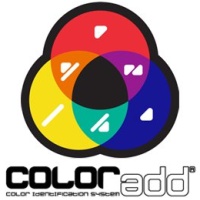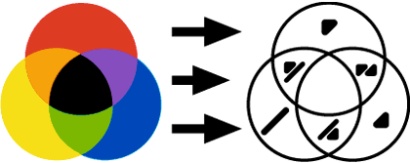
Image Credit: Color ADD
Unprecedented in Portugal and abroad, the color identification system known as Color ADD was born with the aim to create a code that allowed the color blind to identify colors, since their mismatch leads to embarrassing situations and creates a perception of lack of discernment which influences negatively at a social and professional level. The project, which resulted in the Colour Identification System for colour blinds, was created by designer Miguel Neiva based on his Master’s thesis and is already considered to be one of the 40 ideas that will improve the world according to the magazine Galileo of the Globo Media Group from Brazil.
Already regarded as a legacy of Portugal to Humanity, Color Add features a sustainable solution to combat social and professional exclusion that more often than not, the color blind are subject to due to their difficulty in matching colors correctly. With this regard, a necessity to implement a universal code urges, thus creating an undeniable contribution for social inclusion.
“Based on simple premises, we wanted to create a tool that didn’t require a color-blind to put forth his condition in order to use it, to make it easy to learn and able to be immediately put to use by a four year old kid as well as by a ninety year old senior in any part of the world” explains Miguel Neiva, the mentor of this project, to the AUDIÊNCIA newspaper.
Giving shape to the goals set in the theme chosen for his Master’s thesis, the designer created the Color Identification System for color blinds. This code was developed based on the traditional primary colors (red, yellow and blue) represented by means of graphic symbols. The system is built on logical and memorable associations. The concept of adding in colors becomes a game that allows the color blind, through training, to associate the symbols, easily identifying the colors through a combination of basic shapes associated with the basic color combinations (violet, orange, green and brown ).

Representation of colors by use of simple geometric figures - Image Credit: Color ADD
“The project involved eight years of research, starting from scratch since there was nothing of this genre in the world. I decided, first of all, to do a study on the quality of life of color blinds and the data started to emerge: 90% of color blinds ask for help to buy clothes while 41% feel difficulties in social integration, not to mention the fact that an estimated 10% of the male population in the world is color blind”.
Some of the factors that motivated Miguel Neiva to go ahead to break ground for the Color Add project was by means of integrating several national and international conferences to validate the project, including the World Congress of Color in Australia, the 9th International Conference for Visual Semiotics- AISV/IASV in Venice, Italy, the World Congress of Communications and Arts in Portugal, the Conference Nazionale del Colore in Italy, the Global Fashion in Portugal, the Color and Food in Argentina, the 1st International Conference in Design and Graphic Arts-CIDAG2010 and the Design & Graphic Arts event -ARTEC 21 in Portugal.
The project was also awarded the Emerging Design Talent Award by the Royal College of Arts in the United Kingdom and represented Portugal in the European Innovation Festival, held in Tallinn in 2011 (16 to 23 September 2011).
Portuguese companies are more than welcome
“The Color ADD is a project made in Portugal that is innovative, unique, universal and transversal to all the areas of society, regardless of geographic location, culture, language, and religion,” states Miguel Neiva, nevertheless designating certain priority areas in the application of color coding for color vision deficiency, namely Education, Health and Transport.
“Education is one of the priorities because it is in schools that colorblind kids experience the first rejections. Thus, we have pencils from the Portuguese company Viarco with a graphic identification for each colored pencil. Furthermore, we have had contacts for the use of the Color ADD identification of colors in school material, including manuals and the Magalhães personal computer for children, “says the designer.
Another area of application of the system is in healthcare. Mr. Neiva asserts that “through the Manchester triage system, triage tags are assigned to patients whose colors vary depending on the severity of the patients’ condition. The São João Hospital in Oporto has pioneered the use of labeling tapes with the Color ADD symbols. The same holds true for hospital medicine in surgeries, which are identified by color and the Hospital dos Capuchos in Lisbon is now also using this symbol coding to avoid errors, especially in life-threatening and potentially serious conditions. ”
Public transportation is another area in which color identification code for color-blinds is essential since “more than 50 percent of users of subway networks use color as a factor in identifying the destination. With the opening of the station of Santo Ovídio, the Metro do Porto will start implementing the Color ADD system in its entire network”, says Miguel Neiva, which will also meet soon with the Subway networks of London, Brasilia and São Paulo.
In the Textile Industry, there are also companies adopting the Color ADD system like the brand Blankpage; the project has also been considered an influence for the summer 2012 fashion season by Promostyl, a fashion trend agency. But the applications of the color identification system are not limited to these areas, covering also paints for the Construction Industry like CIN and Valentine, the car parking of the Champalimaud Centre for the Unknown in Lisbon, the waste collection and recycling services normalized in a document from the waste management company Lipor and the area of Information Technology, with projects for iPad and iPhone applications.
“I am particularly interested in partners who are Portuguese entities and companies because the notoriety that the color code has obtained worldwide is significant and if I can bring these same entities and companies to be associated with this recognition, so much the better,” says the designer who has, however , the understanding that more than one hundred countries have expressed interest in the project, ensuring the recognition and accreditation of academic, business and global communications mediums.
To conclude, Miguel Neiva has well dimensioned the foundations that led to the development of Color ADD: “To provide color blinds with acquisitive independence and easier social integration in situations where the choice of color is relevant, to minimize the feeling of loss generated by color misinterpretation and consequently experience an increase of well-being and self-reliability “.
More information about Color ADD can be found in their site and in their Facebook page.
*Article written by Filipa Castro Reis from the newspaper Jornal Audiência which was originally published on October 9, 2011 and translated under permission by BestInPortugal.
Image credits: Color ADD
